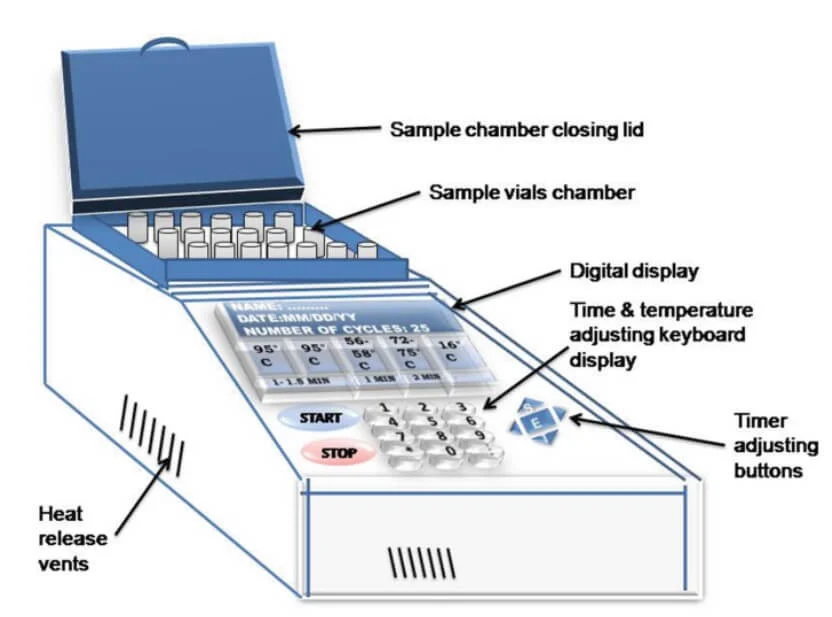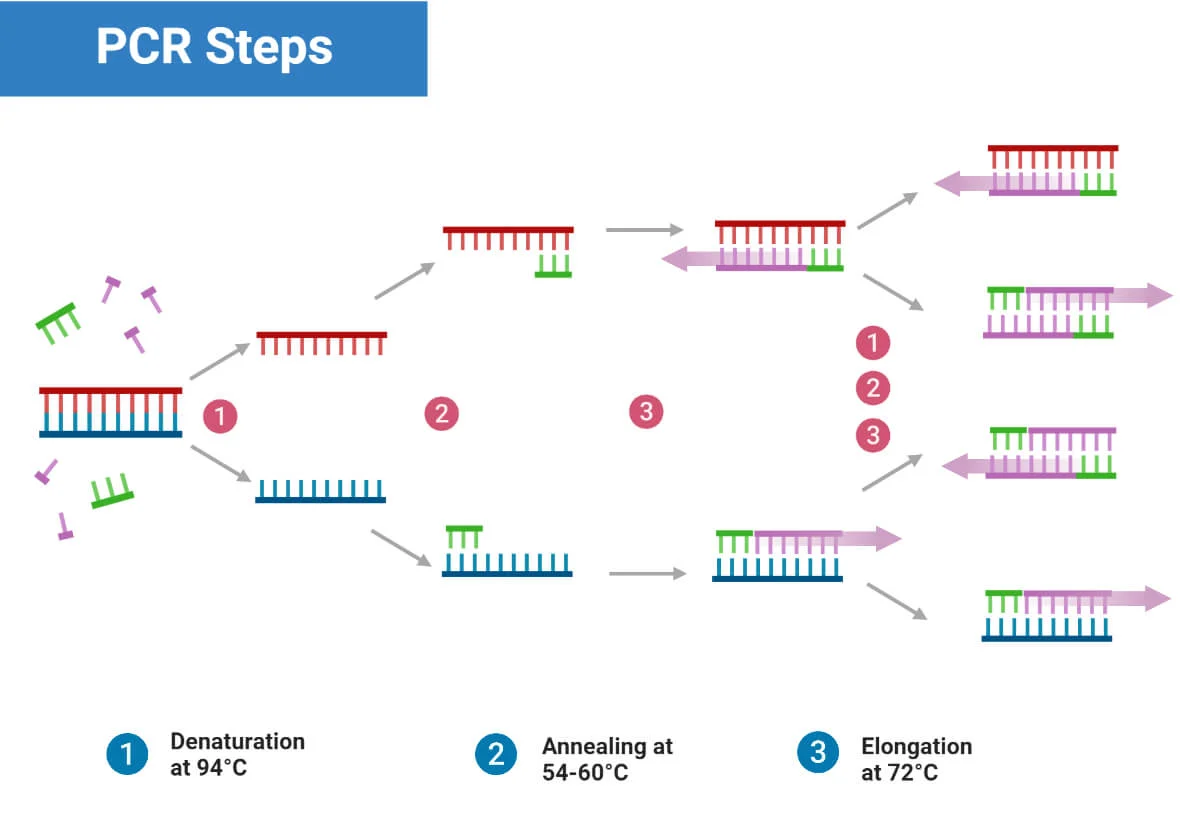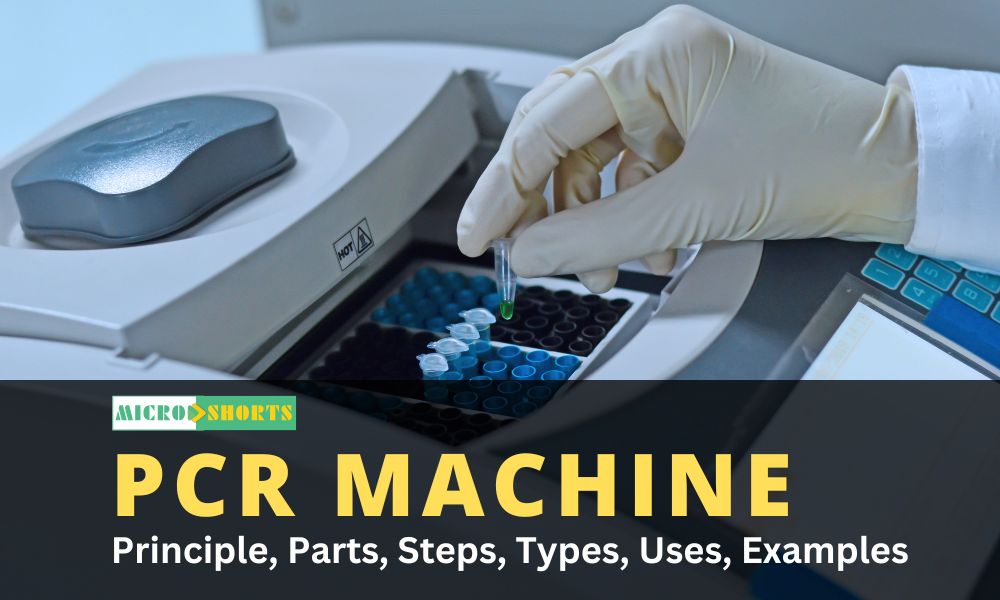PCR machine is also known as thermal cyclers or DNA amplifiers, or thermocyclers. PCR machines amplify small segments of DNA or RNA chosen from the genome with a primer. It is inexpensive and a very effective tool.
It works under the concepts of complementary nucleic acid
hybridization and nucleic
acid replication to exponentially manufacture specific target DNA/RNA
sequences by a factor of 10^7 in a couple of hours.
PCR machines are used in research labs and clinical
diagnostics to replicate DNA, detect DNA sequences, perform DNA fingerprinting,
forensic analysis, and molecular cloning, diagnose genetic diseases, and detect
pathogens like Hep B and C viruses, HIV-1 causing AIDS, Chlamydia
trachomatis, Mycobacterium tuberculosis, Human Papillomavirus, and
Cytomegalovirus. This speed up other temperature-sensitive processes like
restriction enzyme digestion or rapid diagnostics. These amplify segments of
DNA using the polymerase chain reaction (PCR).
PCR, sometimes known as “molecular photocopying’, is
frequently hailed as one of the most significant scientific developments in
molecular biology. It revolutionized the study of DNA to the point where its
inventor, Kary B. Mullis was awarded the Chemistry Nobel Prize in 1993. Without
PCR amplification, examinations of isolated fragments of DNA are almost
difficult since considerable volumes of sample DNA are required for molecular
and genetic analyses.
Principle of PCR
A single-stranded DNA template is used as a scaffold for the
DNA polymerase enzyme, which guides the synthesis of DNA from deoxynucleotide
substrates. When a specially created oligonucleotide is annealed to a longer
template DNA. DNA polymerase adds nucleotides to the 3′ end of the molecule.
Thus, DNA polymerase can employ a synthetic oligonucleotide as a primer and
extend its 3′ end to create an extended stretch of double-stranded DNA when
annealed to a single-stranded template with a region complementary to the
oligonucleotide.
Parts of a PCR Machine

Figure: Parts of a PCR
Machine.
Thermocycler has a thermal block with
holes where tubes holding the reaction mixtures can be inserted.
- It
comes with a heated lid pressed against the reaction tube lids. The lid
prevents condensation of water from the reaction mixtures on the insides
of the lids.
- Rotation
of the lid knob clockwise lowers the heating plate that pressurizes the
cap of the tubes to sit firmly in the block and ensure better contact.
Conversely, its rotation in counter-clockwise directions pops up the lid
so that users can slide the lid to the rear.
- A
control panel includes a large graphical display that facilitates easy
reading and displays the current status of the various system features and
functions and a Key-Pad used to enter the various protocols and settings.
- The
presence of air vents in the front, lateral and bottom
sides facilitates air output and air intake.
PCR Components (PCR reagents)
DNA Template
- It
is crucial to choose the appropriate templates for PCR.
- RNA
templates are needed to create complementary DNA in RT-qPCR whereas DNA
templates are needed for traditional PCR.
- Consequently,
the first stage of a successful PCR requires the use of a reliable PCR
template preparation kit.

PCR Components (PCR reagents)
Thermostable DNA polymerase
- Since
the initial step of PCR requires separating DNA strands at a high
temperature (90 °C), all PCR reactions require a DNA polymerase that can
function at a high temperature (about 70 °C).
- A
popular DNA polymerase for PCR known as Taq polymerase, obtained from the
thermophilic bacteria Thermus aquaticus is a heat-stable
enzyme.
Oligonucleotide Primers
- Primers
are short strands of nucleotides (DNA or RNA) that are complementary to
the template DNA and act as a starting point for the DNA/RNA polymerase to
begin synthesizing new DNA.
- Primers
are short strands of nucleotides (DNA or RNA) that are complementary to
the template DNA and act as the DNA/RNA polymerase’s starting point for
DNA synthesis. They are necessary for the start of DNA synthesis. Lower
temperatures (50–65°C) are needed for annealing primers to single-strand
DNA than for denaturation which generates hydrogen bonds after the
annealing process is finished.
Deoxyribonucleotide triphosphate(dNTPs)
- dNTPs
are required for DNA polymerase to be able to synthesize DNA.
Buffer System
- The
best conditions are always maintained for the PCR reaction thanks to PCR
buffers.
- Tris-HCl,
potassium chloride (KCl), and magnesium chloride (MgCl2) make
up the majority of the ingredients in the PCR buffer.
- In
order to keep the pH steady during PCR, tris-HCl and KCl are used.
In order to ensure that DNA polymerase performs properly DNA synthesis
during PCR, magnesium ions serve as cofactors for the enzyme.
Steps of PCR
Denaturation
- When
the reaction mixture is heated for 0.5 to 2 minutes to 94°C, denaturation
takes place.
- A
single-stranded DNA is created as a result of the hydrogen bonds between
the DNA’s two strands being broken.
- The
single DNA strands now serve as a template for the synthesis of additional
DNA strands.

Figure: Steps of PCR.
Annealing
- For
around 20 to 40 seconds, the reaction temperature is decreased to 54 to 60
°C.
- The
primers attach to the template DNA’s complimentary sequences in this
circumstance.
- Primer
sequences are 20–30 bases long, single-strand DNA or RNA segments.
- They
act as the precursor in the production of DNA.
- There
are two primers—a forward primer and a reverse primer—the two separated
strands run in opposing directions.
Elongation
- The
temperature is increased to between 72 and 80 degrees Celsius at this
stage.
- The
Taq polymerase enzyme tacks the bases onto the primer’s 3′ end. As a
result, the DNA stretches from 5′ to 3′.
- Taq
Polymerase can withstand extremely high temperatures. A double-stranded
DNA molecule is produced as a result.
In order to obtain several DNA sequences of interest in a
short amount of time, these three procedures are done 20–40 times.
PCR Machine Operating Procedure
- Initially,
the sample is heated with the use of a PCR machine which causes the
denaturation and separation of the DNA into two pieces of single-stranded
DNA.
- Following
that, an enzyme known as “Taq polymerase” creates or constructs two new
DNA strands using the old strands as templates.
- Due
to this procedure, the original DNA is duplicated, with one old and one
new strand of DNA present in each new molecule.
- After
that, each of these strands can e used to make two other copies, and so
on.
- There
are more than one billion exact replicas of the original DNA segment when
the cycle of denaturing and creating new DNA is repeated up to 30 or 40
times.
- The
entire PCR cycling procedure is automated and can be finished in a matter
of hours. The reaction is controlled by a device known as a thermocycler,
which is configured to change the temperature of the reaction every few
minutes to enable DNA denaturation and synthesis.
Types of PCR
Real-time
PCR, also known as quantitative PCR or qPCR, is a technique
for monitoring and quantifying PCR results in real-time by labeling DNA
molecules with fluorescent dye.
Reverse-Transcriptase (RT-PCR) converts RNA to
DNA in the process of producing complementary DNA (cDNA).
Nested PCR lowers the possibility of undesired
products by conducting a second PCR using new primers “nested” within the
initial 25–35 PCR cycles.
Hot Start PCR uses heat to denature antibodies
that are used to inactivate Taq polymerase.
Multiplex PCR multiplies several fragments in a
single DNA sample by using a number of primers.
Long-range PCR uses a variety of polymerases, to
generate larger DNA ranges.
In situ PCR is a type of PCR that occurs in
cells or fixed tissue on a slide
One strand of the target DNA is amplified by an asymmetric
PCR process.
Use of overlapping primers in assembly PCR allows
for the amplification of longer DNA fragments.
PCR Applications
- Gene
transcription
- PCR
can investigate differences in gene transcription among various cell
types, tissues, and species at a particular time period.
- Reverse
transcription is used to create cDNA by isolating RNA from samples
of interest.
- The
quantity of cDNA produced by PCR can then be used to calculate the
original RNA levels for a particular gene.
- Genotyping
- Sequence
differences in alleles of certain cells or organisms can be determined.
- Genotyping
of transgenic organisms facilitates the amplification of the mutation or a
transgenic part.
- Cloning and mutagenesis
- PCR
cloning makes it possible to breed new strains of bacteria with altered
genetic makeup via the insertion of amplified dsDNA fragments into the
vectors such as gDNA, cDNA, and plasmid DNA.
- Cloning
assists in introducing point mutations using site-directed mutagenesis
which itself employs the recombinant PCR method.
- It
also helps to create novel gene fusions.
- Sequencing
accompanies the amplification of template DNA, their purification, and
processing through a sequencing step.
- PCR
is also employed in next-generation sequencing (NGS) during the library
preparation phase to quantify DNA samples and tag them with sequencing
adaptors for multiplexing.
- Medicine
and biomedical research
- Medical
applications include genetic changes linked to disease to identifying
infectious organisms. Prenatal genetic testing employs PCR to detect
chromosomal abnormalities and genetic mutations in the pregnancy,
providing expecting parents with crucial information about the likelihood
that their children will have a particular genetic illness.
- It
can also be employed as a preimplantation genetic diagnosis technique to
screen embryos for in vitro fertilization (IVF).
- Forensic
Science
- PCR
can be useful for forensic investigations to identify the sources of
samples and paternity testing.
- It
is used in molecular archaeology to amplify DNA from artifacts.
- Environmental
microbiology and food safety
- Pathogens
can be found using PCR, not just in patient samples but also in matrices
like food and water. This is important for both diagnosing and preventing
infectious diseases.
PCR Advantages
- Allows
for quicker, more informed decision making
- Rapid
identification of bacteremia, especially for specimens with low bacterial
counts
- Effective
in identifying cases in extrapulmonary specimens that smear and/or culture
may have missed.
- Important
for identifying certain diseases that are challenging to cultivate in
vitro or take a long time to cultivate. Significantly faster at producing
results than cultivating
- It
is still regarded as an auxiliary test for some diagnostic procedures that
depend on smear and culture such as Tuberculosis.
- It
has the ability to test for antimicrobial resistance.
PCR Limitations
- Unknown
target amplification is not possible with PCR. The design of the primers
requires knowledge about the target sequence in advance.
- Error-prone
DNA polymerases have the potential to lead to PCR product mutations.
- PCR
is extremely susceptible to contamination. Results could be misinterpreted
or confusing if there is even a little amount of contaminated DNA.
- With
the increase in amplicon size, PCR efficiency decreases.
Precautions using PCR Machine
- Only
tubes and plates designed for the PCR machine should be used.
- Before
running, double-check tubes and, in particular, plates are tightly sealed.
- Solution
spills should be cleaned up, and biohazard containers should be used for
disposal.
- Be
cautious when using a PCR machine lid. If you drop or bang lids, this
could get broken.
- Once,
the use of the PCR machine is finished, it should be turned off.
- Prior
to beginning a run, make sure the PCR heating block is clean. Before
beginning, inspect every tube holder.
- To
ensure that the lid sits flat against the top of the tubes for even
heating and sealing, distribute the tubers evenly over the block.
PCR Machine Examples
Biometra TAdvanced Thermal Cycler Series (Analytik Jena)
- Twelve
distinct sample blocks, including a high-end 96-well silver block
- With
today’s powerful control electronics, even an aluminum block can produce
faster heating and cooling than is often possible with silver block-only
instruments.
- Fastest
Ramping, Highest Accuracy, and Intelligent Block/Well Control (RAC)
provide the highest temperature uniformity and reproducibility with zero
over- or undershoot of the programmed target temperature.
- Fast
heating, continuous contact pressure, and simplicity of use are all
features of High-Performance Smart Lid Technology (HPSL).
MiniAmp™ Plus Thermal Cycler (ThermoFisher Scientific)
- VeriFlex
Blocks have three distinct temperature zones that allow you to precisely
manage the temperature for your PCR optimization.
- A
5-inch intuitive color touch-screen that is simple to program and instruct
new users on Compact size—With a footprint of just 19 cm wide and 39 cm
deep, the MiniAmp Thermal Cycler can fit almost any place. Thermo Fisher
Connect’s WiFi capabilities enable you to design and securely upload your
methods from any mobile device or desktop computer.
- Additionally,
because its airflow is front to back, you can place multiple unit side by
side to save valuable bench space.
PCR Thermal Cyclers (Esco)
- For
all types of PCR processes, including gradient PCR, touchdown PCR, high
throughput PCR, in situ PCR, and others that use a range of PCR tubes,
strips, plates, and slides,
- Esco
offers a selection of conventional thermal cycler and real time thermal
cycler models that are built to meet stringent requirements.
- In
order to establish and maintain accurate control and quick ramp rates with
little overshoot or undershoot for process speed and accuracy, Swift
thermal cyclers use cutting-edge Peltier temperature control technology.
GET-S SERIES THERMAL CYCLER (Bio-gener)
- An
extended service life peltier is used in the GET-S series thermal cycler.
Its maximum ramping rate is 4.5 °C/s, and its cycle times exceed one
million.
- The
product integrates a number of cutting-edge technology, including the
Android operating system, a color capacitive touch screen, many block
possibilities, an integrated WIFI module, PC software control
functionality, email notification functionality, a large storage capacity,
and more.
- The
aforementioned features enable PCR’s great performance and satisfy more
demanding experiment requirements.
MiniAmp Plus Thermal Cycler and the MiniAmp Thermal Cycler (Delta Science)
- Fits
on any benchtop because to its small size.
- With
Thermo Fisher Connect, you can easily access your instrument from any
location that has access to the internet.
- When you upgrade to the Applied Biosystems MiniAmpTM Plus Thermal Cycler, you have the option to get VeriFlexTM temperature control technology for PCR optimization.









Comments